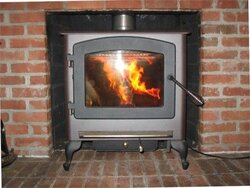First, I agree with Begreen. Even in a moderate climate like DC, a 40 foot (especially if inside)pipe and 8 inch diameter is going to give you monster draft. Zone 5 with over 30 feet of 6 inch pipe I have too much draft.
I agree with Grisu, you are unnecessarily restricting yourself if you avoid a cat. Don't know how big your home is, but, for instance, a Woodstock Fireview heats easily 1600 feet providing all heat in a climate like yours. It is incredibly easy to use...has a one day learning curve for someone who has never heated with wood, I would say. Of course, with any stove as with anything else, the more you use it and the more you care about its performance, the longer your fine-tuning learning curve. Cat doesn't need to be cleaned more than once a year, incredibly easy to get at, takes maybe 10 minutes to clean. Cat stove uses less wood for same heat production. There are very good cat stoves from a number of manufacturers, many rear vented. Woodstock's Progress Hybrid or Lopi's Cape Cod, and Woodstock's upcoming Union Hybrid, should you have a larger home, will produce a ton of heat when burning at reasonable rates. They have large glass windows and heat a room quickly. I think any stove with a large window radiates heat pretty quickly. I'm guessing you want steel for rapid heat production...not necessary with the large windows.
Don't know why you want a fan if the stove is out in the room. Not necessary, is noisy, uses electricity, one more thing to go wrong and to maintain.
So, not suggesting you avoid steel, just suggesting you not restrict yourself by doing so.
Does appearance matter to you at all? How big is your home? Do you just want a fire for ambiance on weekends? Any chance you'll want to eventually heat the home if you find the stove easy to use, or are you in a situation where you cannot handle/store enough wood to do so? MANY end up heating 24/7 when they realize how easy the stoves are to use, and how comfortable the heat.
You'll be happy with a cat or secondary burn stove, if you get one you like the appearance of and that will do what you want it to in terms of producing heat. All the better stoves burn very well and give a great view of the fire. You can burn with an active (read very active) flame in a cat or non-cat stove. That's your call, any given day. The cat allows you to leave the fire burning very slowly while producing lots of heat when you are not in the room. Back in the room and you want active flames, you can just open the air a bit more and let the fire burn hotter.
So tell us what it is you want to accomplish, and we can be more helpful.



 I sleep under a sheet on about three cords a year.
I sleep under a sheet on about three cords a year.